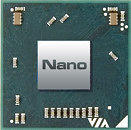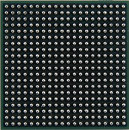CrazyBomber
Power Member
Então ainda ninguém postou isto aqui? Parece que a VIA anda a trabalhar bem 
Fonte: HardOCP
Nada que vos faça trocar o belo do QuadCore, mas parece-me uma óptima alternativa para Media centers, escritórios, etc. Bom bom era se fosse ao preço dos Celeron

If you would have told me last year that I would be able to sit down and play Crysis on a VIA low power CPU, well, I think I would have to had called BS on that, but I did just that yesterday. That get your attention?
This new processor for Centaur and VIA will be an out-of-order superscaler single core CPU at launch. Initially it will not have SSE4 instructions but that will be added on one of it first updates later this year and even a dual core version is possible but not yet planned. The amazing thing about this new processor, which we will refer to as the "CN" (which has yet to be branded, and let's hope VIA comes up with something better than "C7" this time round) from here out, fits into the same power envelope as the current C7. A current C7 at 1.5GHz is rated at 25w TDP. A new CN at 2GHz should fetch 20w TDP or less. (I should mention here that TDP numbers are somewhat misleading. Under normal usage models a 2GHz would likely fetch between 2w to 5w. I also previously misstated that TDP was higher than 20w. 20w is correct and has been verified by Centaur.) Update - 012408:0957) The new CN is pin compatible with the C7 as well. It is entirely possible to take this new CN processor, which could be categorized as being at least “2X more powerful than the C7,” and drop it into current C7 devices. Launch is slated for "Spring of 2008."
We saw a 1.4GHz CN processors running a Blu-ray HD video easily as well as a 1.2GHz passsively cooled CN running 720P video content and plowing through a desktop application benchmark. (Updated 012408:0800_
Without a doubt, what was most impressive was seeing a 1.8GHz CN processor running Crysis. While I am not going to go out of on a limb and say it was the best Crysis experience you might have, there is no doubt that this low power “UMPC” processor was more than up to the task that I would never ever guessed possible on a VIA/Centaur CPU.
A 64-bit superscaler out-of-order processor with enough performance to run Crysis crammed into a 60mm^2 area pulling less than 35w that can be dropped into current UMPC devices fitting into the palm of your hand? Sign me up VIA.
Fonte: HardOCP
Nada que vos faça trocar o belo do QuadCore, mas parece-me uma óptima alternativa para Media centers, escritórios, etc. Bom bom era se fosse ao preço dos Celeron







